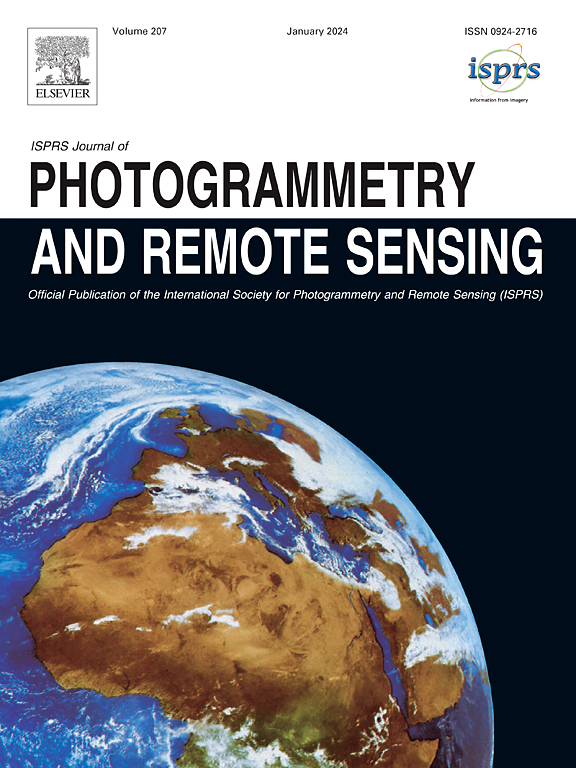时延多普勒图像与时空回波相似度相结合的SAR高度计三维定位
IF 10.6
1区 地球科学
Q1 GEOGRAPHY, PHYSICAL
ISPRS Journal of Photogrammetry and Remote Sensing
Pub Date : 2025-03-12
DOI:10.1016/j.isprsjprs.2025.02.027
引用次数: 0
摘要
合成孔径雷达(SAR)高度计是一种广泛应用于卫星微波遥感的有源传感器。它还可以通过评估获取的地形剖面与先前数据之间的相似性来用于地球物理定位。然而,地形线性假设、地面高程变化大、波束宽度宽等典型因素会降低定位的定位精度。提出了一种结合延迟多普勒图像(DDI)和时空回波相似度的SAR高度计三维定位方法。首先,建立了用于DDI成像的SAR高度计信号模型。然后,开发了DDI的图像匹配算法,实现了沿轨道和高度方向的定位。此外,利用时空相似度来处理交叉航迹定位误差。该方法的主要优点是可靠的三维定位,特别是对于极端的雷达配置,如大波动和宽波束宽度。基于仿真和实际数据的实验结果验证了该方法的有效性,表明该方法的定位精度得到了显著提高。本文章由计算机程序翻译,如有差异,请以英文原文为准。
SAR altimeter 3-D localization with combined Delay Doppler Image and spatio-temporal echo similarity
The Synthetic Aperture Radar (SAR) altimeter is an active sensor, which is widely used in satellite microwave remote sensing. It can be also used for geophysical localization by evaluating the similarity between the acquired terrain profile and the prior data. However, typical factors, such as the linear assumption of terrain, high variation of the ground elevation, and wide beam width will degrade the positioning accuracy of localization. In this paper, a 3-D localization method combining Delay-Doppler Image (DDI) and spatio-temporal echo similarity is proposed for the SAR altimeter. Firstly, the signal model of the SAR altimeter for DDI imaging is established. Then, the image-matching algorithm for the DDI is developed to achieve localization in the along-track and height directions. Additionally, spatio-temporal similarity is used to deal with cross-track positioning errors. The main advantage of the proposed method is the reliable 3-D localization, especially for extreme radar configurations, such as large undulations and wide beam width. Experimental results based on both simulated and real data validate the method, showing a significant improvement in localization accuracy.
求助全文
通过发布文献求助,成功后即可免费获取论文全文。
去求助
来源期刊

ISPRS Journal of Photogrammetry and Remote Sensing
工程技术-成像科学与照相技术
CiteScore
21.00
自引率
6.30%
发文量
273
审稿时长
40 days
期刊介绍:
The ISPRS Journal of Photogrammetry and Remote Sensing (P&RS) serves as the official journal of the International Society for Photogrammetry and Remote Sensing (ISPRS). It acts as a platform for scientists and professionals worldwide who are involved in various disciplines that utilize photogrammetry, remote sensing, spatial information systems, computer vision, and related fields. The journal aims to facilitate communication and dissemination of advancements in these disciplines, while also acting as a comprehensive source of reference and archive.
P&RS endeavors to publish high-quality, peer-reviewed research papers that are preferably original and have not been published before. These papers can cover scientific/research, technological development, or application/practical aspects. Additionally, the journal welcomes papers that are based on presentations from ISPRS meetings, as long as they are considered significant contributions to the aforementioned fields.
In particular, P&RS encourages the submission of papers that are of broad scientific interest, showcase innovative applications (especially in emerging fields), have an interdisciplinary focus, discuss topics that have received limited attention in P&RS or related journals, or explore new directions in scientific or professional realms. It is preferred that theoretical papers include practical applications, while papers focusing on systems and applications should include a theoretical background.
 求助内容:
求助内容: 应助结果提醒方式:
应助结果提醒方式:


